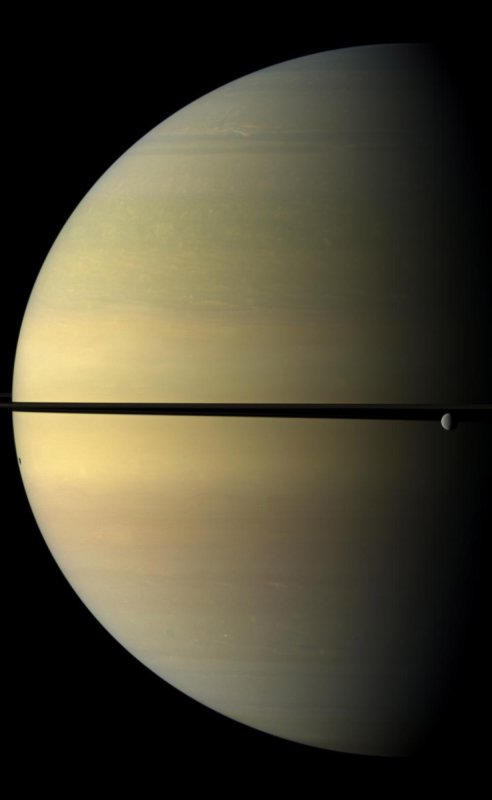Saturn is seen with one of its moons, Rhea, orbiting beyond the rings on the right of the image taken using red, green and blue spectral filters to create this natural color view. The moon Tethys is not shown here, but its shadow is visible on the planet on the left of the image. The images were obtained with the Cassini spacecraft wide-angle camera on November 4, 2009, at a distance of approximately 808,000 miles from Saturn. UPI/NASA |
License Photo
PASADENA, Calif., Nov. 26 (UPI) -- NASA's Cassini space probe orbiting Saturn has found evidence of an atmosphere on Rhea, one of the ringed planet's moons, U.S. researchers say.
The spacecraft has detected a very thin atmosphere containing oxygen and carbon dioxide around the icy moon, a NASA release said Friday.
This marks the first instance of a spacecraft directly capturing molecules of an oxygen atmosphere -- admittedly a very thin one -- at a world other than Earth, scientists said.
The formation of oxygen and carbon dioxide, as detected on Rhea, could possibly drive complex chemistry on the surfaces of many icy bodies in the universe, researchers say.
"The new results suggest that active, complex chemistry involving oxygen may be quite common throughout the solar system and even our universe," Ben Teolis, a Cassini team scientist based at Southwest Research Institute in San Antonio, said.
"Such chemistry could be a prerequisite for life," he said.
But, he added, "All evidence from Cassini indicates that Rhea is too cold and devoid of the liquid water necessary for life as we know it."
The oxygen and carbon dioxide atmosphere makes Rhea, Saturn's second-largest moon, unique in the Saturnian system.
The planet's largest moon, Titan, has a thick nitrogen-methane atmosphere but very little carbon dioxide and oxygen.
"Rhea is turning out to be much more interesting than we had imagined," Linda Spilker, Cassini project scientist at NASA's Jet Propulsion Laboratory in Pasadena, Calif., said. "The Cassini finding highlights the rich diversity of Saturn's moons and gives us clues on how they formed and evolved."















